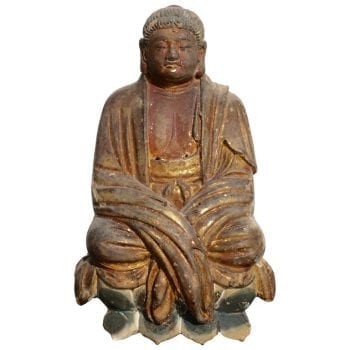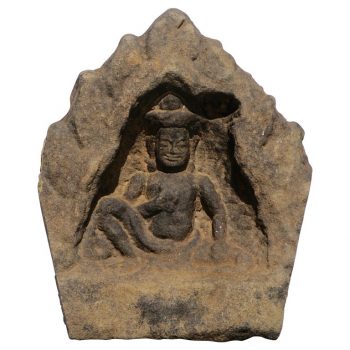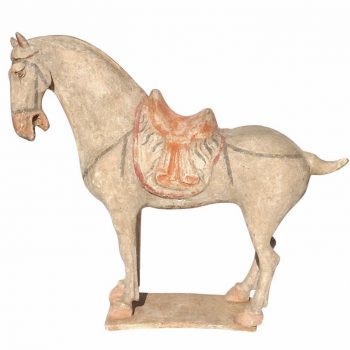Description
Chinese, Tang Dynasty 618 AD to 906 AD Pottery Lokapala Figires
Two painted earthenware Lokapala with helmets and armored bodies with flame form finials emanating from dragon form epaulettes on the shoulders. The figures standing on imps, on rockwork form bases.
Dimensions: (larger) H. 38″ W. 13″ D. 10″. Approximations
Provenance: From the Private Collection of Morton & Kathleen Sachs of Louisville, Kentucky, purchased from TK Asian Antiquities (Williamsburg, VA) in 2000.
Condition: Wear commensurate of age and use. Very few professional repairs throughout with losses to polychrome pigments. Some stable straight hairlines, Present beautifully.
Chinese, Tang Dynasty. Two painted earthenware Lokapala with helmets and armored bodies with flame form finials emanating from dragon form epaulettes on the shoulders. The figures standing on imps, on rockwork form bases. Approx: (larger) h. 38″ w. 13″ d. 10″. Provenance: From the Private Collection of Morton & Kathleen Sachs of Louisville, Kentucky, purchased from TK Asian Antiquities (Williamsburg, VA) in 2000
AVANTIQUES is dedicated to providing an exclusive curated collection of Fine Arts, Paintings, Bronzes, Asian treasures, Art Glass and Antiques. Our inventory represents time-tested investment quality items with everlasting decorative beauty. We look forward to your business and appreciate any reasonable offers. All of our curated items are vetted and guaranteed authentic and as described. Avantiques only deals in original antiques and never reproductions. We stand behind our treasures with a full money back return if the items are not as described.
The Tang Dynasty was an era of unrivalled wealth and luxury. The country was successfully reunified and the borders were expanded, pushing Chinese influence into new lands. Confucianism became a semi-religious instrument of the state; yet Buddhism continued to flourish, spreading into Korea and Japan. The arts reached new levels of sophistication. Poetry and literature flourished under the enlightened rulers. The Silk Road brought fortunes into China. Precious treasures were imported on the backs of camels from far away lands and bartered for Chinese silk, medicinal herbs, and pungent spices. T’ang China was a multicultural empire where foreign merchants from across Central Asia and the Middle East settled in the urban centers, foremost among them the thriving capital of Chang’an (modern X’ian), a bustling cosmopolitan center of over two million inhabitants. Foreign traders lived next to native artisans and both thrived. New ideas and exotic artistic forms followed alongside. The T’ang Dynasty was a cultural renaissance where many of the forms and objects we now associate with China were first created. Moreover, this period represents one of the greatest cultural outpourings in human history.
During the Tang Dynasty, restrictions were placed on the number of objects that could be included in tombs, an amount determined by an individual’s social rank. In spite of the limitations, a striking variety of tomb furnishings have been excavated. Entire retinues of ceramic figures – animals, entertainers, musicians, guardians – were buried with the dead. Many of the objects reflect Tang China’s extraordinary amount of contact with foreigners, bringing into China influences that were then adapted and absorbed into its culture. One of these influences is apparent in this figures that corresponds to Buddhist warrior deities that assume a mortuary role in China but also serve as protectors of Buddhist temples. Known as “Protector of the Burial Vault” or “Protector of the Burial Ground,” , these guardians stands atop a grotesque demons. This stance symbolizes the heavenly king’s authority and responsibility as protector of the tomb. They wear a suit of armor that retains a remarkable amount of its original orange and white pigment.
According to one Chinese tradition explaining their origin, the emperor Taizong when ill was threatened by ghosts outside of his room screeching and throwing bricks and tiles. When his general Jin Shubao (Chin Shu-pao) and a fellow officer came to stand guard the activity of the ghosts ceased. The grateful emperor had portraits of the two men hung on either side of his palace gates, and thereafter their images became widespread as door-gods. Originally, they would have brandished weapons fabricated in a material such as wood that has deteriorated over the centuries. Looking unto their stern faces and flaming hair and gazing into their fierce eyes, we understand why such works were intended to frighten away tomb robbers and evil spirits. Yet despite their intimidating nature, we are not repelled by them; instead, we are attracted to their artistic mastery and intriguing history.
Please also consider Avantique’s antique and ancient Asian Art Collection of Han Dynasty, Tang Dynasty, Ming Dynasty, Qing, and Republic period items to complete your home and office decorations with class. Avantiques has Asian pottery, terra cotta, bronze, and paintings to complement your collection. We strive to collect the highest quality Asian antiquities in exceptional condition.





